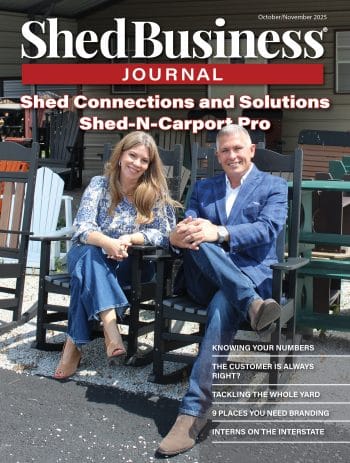
Regional trends in shed building are mainly shaped by climate, geography and demographics. You won’t see a surf hub shed in Minneapolis or an ice-fishing shed in Miami. But, there’s one shed-building requirement that doesn’t change regardless of the location: durability.
I recently spoke with Lenny Stahl, co-owner and president of Dakota Storage Buildings in Milbank, South Dakota, about what shed durability means in the Upper Midwest. Average winter lows there are in the single digits, and hail storms are getting more destructive.
“I’ve seen firsthand how durable products like engineered wood stand up in poor weather conditions, and it’s something I always highlight to my customers,” says Stahl. “The warranty for LP®SmartSide®siding products includes protection against hail damage, which is especially important in harsher climates.”
PROTECTING SHEDS IN ‘HAIL ALLEY’
Each year there are about 5,000 dangerous hail events in the United States, most of them in the “Hail Alley” corridor that Stahl serves. Third party testing showed hail of 1.25-inch diameter made pockmarks in vinyl siding, and 1.75-inch hail dented fiber cement siding. LP SmartSide Strand Substrate Lap Siding showed no signs of impact after being hit with 1.75-inch hail at 81 mph.
“I look for products that stand up against the elements and deliver when it comes to long-term durability,” says Stahl. “When you work with ‘knock-off’ products, you end up with ‘knock-off’ results.”
SAFEGUARDING SPECIALTY SHEDS
Stahl notes that the issue of durability is important no matter the shed’s use—whether it’s as a traditional storage unit or has a more unique use.
“I’m currently experimenting with sheds that can be used for art studios or fitness areas,” says Stahl. “This type of shed has a sloped roof and a much more modern look than a traditional storage shed. It’s designed to look more like an extension of the home rather than a storage unit.”
A fitness shed requires flooring strong enough to support cardio equipment. An engineered wood floor is specially designed to resist bending, splitting or cracking.
Although the Upper Midwest isn’t a termite magnet like the Southeast, homes and sheds there can get infiltrated by termites. Engineered wood products are designed specifically to resist both termite damage and fungal decay, so people can practice their hobbies for years to come.
PREPARING FOR FREEZE/THAW
It’s common for cities in the Upper Midwest to experience 80 days or more of freeze/thaw cycles each year. This cycle of freezing following by warmer temperatures can cause significant damage to some types of siding. Because engineered wood products are made from a combination of treated wood fiber and industrial-grade binders and resins, its able to withstand damage from freeze/thaw cycles.
With dependable material, Stahl says, he can confidently sell sheds that stand up against harsh winters.
“I really enjoy helping people organize their lives and safe keep their possessions,” says Stahl. “What really keeps it fun is delivering durable, high-quality sheds.”




